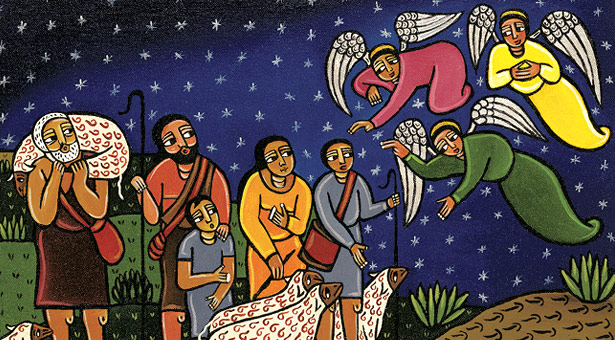The Bible & Theology Toward Christian Maturity
Jesus According to Luke
A Gospel's Unique Contribution to What We Know of Christ
By Mark Abbott, Instructor of Preaching and Winter Quarter Lectio Writer

Laura James, “The Annunciation to the Shepherds,” Acrylic on Canvas, 14 ̋ × 18 ̋, 2000. Private Collection / The Bridgeman Art Collection.
As a preaching pastor for more than four decades, I periodically dipped into the Gospel of Luke
for a Sunday sermon. Of course,
at least once at Christmas there would be a sermon from Luke's
wonderful story of Jesus' birth. But seldom have I looked at the whole Gospel of Luke as I did
in preparation for writing the Lectio: Guided Bible Reading for Winter Quarter.
I found that covering Luke's Gospel in 11 chapters of 2,500 words each was a major challenge.
But I also found myself involved in more than a writing assignment as I opened up this remarkable story of Jesus according to Luke. While I tried to make some of the important scholarship on this gospel accessible, my main motivation was pastoral. I tried to make Luke's portrait of Jesus accessible to a contemporary college freshman.
Here are some of the things I observed about how this wonderful segment of Scripture deals with Jesus:
Luke was a serious historian, careful in his writing and elegant in his language. As N.T. Wright
observes, Luke “was an educated and cultured man, the first real historian to write about Jesus.
His book places Jesus not only at the heart of the Jewish world of the first century, but at the heart
of the Roman world into which the Christian gospel exploded.”
Luke continues his story into this Gospel's sequel, the Acts of the Apostles.
Luke depicts Jesus in his short-lived ministry as deeply compassionate — caring for the poor, the oppressed, and the marginalized of that culture, such as Samaritans, Gentiles, and women. Whereas Matthew traces Jesus' genealogy to Abraham, father of the Jewish people, Luke goes back to Adam, parent of us all.
Again and again, Luke zeros in on women, who were seen as second-class citizens in the first century. The first birth announcement for Jesus, as Luke tells it, was made to shepherds “living in the fields,” and were among the lowest in that society's pecking order. Jesus' ministry was for all, especially for those who were rejected or diminished in value by their society.
Luke places special emphasis on the Holy Spirit and on prayer. After highlighting the role of
the Holy Spirit in the birth and ministry of Jesus, Luke begins the sequel to his gospel by telling
of the Holy Spirit's outpouring (Acts 2). As to prayer, Luke not only pictures Jesus at prayer but
also includes several parables that highlight the importance of prayer. As you read Luke, be alert
to how often these themes appear in this Gospel.
Some of Jesus' most powerful parables are uniquely recorded in Luke: The Good Samaritan
(10:25–37), The Rich Fool (12:13–21), The Prodigal Son (15:11–32), The Rich Man and Lazarus
(16:19–31), The Persistent Widow (18:1–8), and The Pharisee and the Tax Collector (18:9–14).
Luke describes Jesus on the road. He gives us a longer “travel narrative” than the other gospels
(9:51–18:14). While on his extended journey to Jerusalem, Jesus heals, teaches, and disciples his followers. Then, the book climaxes on the road to Emmaus (24:13–35). Luke's Jesus is on a journey with us.
While I am very grateful for the vital diversity in the four-gospel story we have of Jesus, I
celebrate this wonderful story of Jesus according to Luke.
